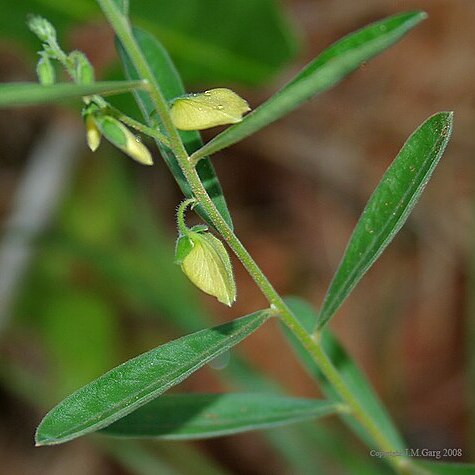Herbs annual, 20-47(-150) cm tall. Stems slender, winged or ridged, sparsely pubescent, little branched. Leaves subsessile; leaf blade papery; basal leaves dense, ovate, 5-10 × ca. 5 mm; upper leaves sparse, lanceolate to elliptic-lanceolate; subterminal leaves linear-lanceolate, 2-2.5 × 0.2-0.5 cm, green, glabrescent, midvein raised abaxially, impressed adaxially, lateral veins obscure, base cuneate, margin entire, slightly recurved, apex acuminate. Racemes terminal, ca. 5 cm, to 10(-20) cm after anthesis, glabrous or slightly pubescent, densely flowered; bracteoles 3, caducous, pubescent, median one triangular-subulate, ca. 2 mm, lateral ones ovate-lanceolate, ca. 1 mm. Sepals 5, persistent; outer sepals 3, median one keel-like, ca. 2 mm, lateral ones small; inner sepals 2, petaloid, obovate, ca. 3 × 2 mm, base unguiculate, apex rounded. Petals 3, connate in lower 1/3, pink or purplish; lateral petals shorter than keel, subrhomboid or ± obovate; keel apex with papilionaceous appendages. Stamens 8, lower 1/2-3/4 united forming an open staminal sheath, split in upper 1/4-1/2 into 8 free filaments; anthers yellow, ovoid. Ovary ovoid, ca. 0.5 mm in diam.; style curved, hooklike; stigma mammilliform. Capsule oblong, ca. 3 mm, ca. 2 mm in diam.; carpel with foveolate striation, margin unequally obliquely winged. Seeds black, oblong, white pubescent; strophiole white, membranous, pubescent, 3-lobed. Fl. and fr. Aug-Nov.
Annual, erect, little-branched herb up to 80 cm high. Stem ribbed, glabrous or upwards set with short, curved hairs. Leaves proportionally few, linear to linear-lanceolate, the lowest ones slightly broader, 10-55 by 1-6 mm, subsessile, acute, with recurved margins, (sub)glabrous, l-nerved. Racemes mostly terminal, 2-20 cm long, dense. Bracts and bracteoles early caducous. Flowers 3-4, in fruit up to 5 mm long (including the alae), lilac, turning purple, when dry whitish. Outer sepals acute, glabrous to ciliate, alae elliptic to obovate, rounded, 3-nerved, glabrous. Upper petals oblong, glabrous or rarely hairy inside in basal half; keel not auriculate, glabrous or rarely sparsely hairy outside, apically with 2 rather few-divided appendages. Filaments free for ¼-½. Ovary elliptic, glabrous; style strongly curved, (sub)apically at inner side with a single, relatively large, knob-shaped stigmatic lobe. Capsule shorter than the alae, broadly elliptic to obovate, c. 3-3.5 mm long, emarginate, with a narrow, veined, glabrous wing widening apically. Seeds oblong, at micropylar side with a small, unequally 3-lobed aril, dark, hairy.

